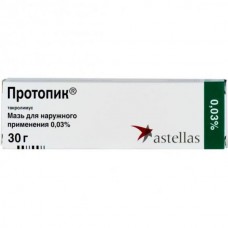Expiration date: 02/2025
The composition and form of issue:
Ointment for external use. 100g contains active substance:
tacrolimus (as tacrolimus monohydrate) 0.03g or 0.1 g
excipients: paraffin-soft white paraffin-liquid propylenecarbonate beeswax white wax solid
in plastic tubes of 10, 30 or 60 g in a cardboard bundle 1 tuba.
Description pharmaceutical form:
Ointment of uniform consistency from white to slightly yellowish.
Pharmacokinetics:
Absorption. The absorption of tacrolimus into the systemic circulation when applied topically is minimal. Most patients with atopic dermatitis (adults and children) as a single application and repeated application of 0.03 and 0.1% tacrolimus ointment concentration in plasma was <1 ng/ml Systemic absorption depends on lesion size and decreases with the disappearance of clinical manifestations of atopic dermatitis. Of drug accumulation with long-term use (up to 1 year) in children and adults were noted.
Distribution in the body. Due to the fact that systemic absorption of tacrolimus ointment is low, a high ability to contact proteins of plasma (>98.8 per cent) is regarded as clinically relevant.
Metabolism. Tacrolimus is not metabolized in the skin. When injected into the systemic circulation of tacrolimus is largely metabolized in liver by CYP3A4.
Excretion. Repeated topical application of tacrolimus ointment T1/2 — 75 hours for adults and 65 hours for children.
Description pharmacological action:
Tacrolimus belongs to a group of calcineurin inhibitors. It binds to a specific cytoplasmic protein immunophilin (FKBP12), which is a cytosolic receptor for calcineurin (FK506). As a result, formed a complex with tacrolimus, FKBP12, calcium, calmodulin and calcineurin, which leads to inhibition of phosphatase activity of calcineurin. This prevents dephosphorylation and translocation of nuclear factor of activated T cells (NFAT) necessary for the initiation of transcription of genes encoding products crucial for T-cell immune response cytokines (IL-2 and interferon-gamma). In addition, tacrolimus inhibits the transcription of genes coding for the production of such cytokines as IL-3, IL-4, IL-5, granulocyte-macrophage colony stimulating factor (GMCSF) and TNF-&alpha, involved in the initial stages of activation of T-lymphocytes. In addition, under the influence of tacrolimus is the inhibition of release of mediators of inflammation from mast cells, basophils and eosinophils and reduced expression of Fc&epsilonRI (high-affinity surface receptor for IgE) on Langerhans ' cells, which leads to a decrease in their activity and prezentowania antigen T-lymphocytes.
Tacrolimus ointment does not affect collagen synthesis and thus does not cause atrophy of the skin.
Indications:
Protopic ointment is applied in a dosage of 0.03 and 0.1% in adults, and only 0.03% for children aged 2 to 16 years for the treatment of atopic dermatitis (moderate and severe) in the case of resistance to other means of external therapy or the presence of contraindications such.
Contraindications:
- hypersensitivity to tacrolimus, auxiliary substances, macrolides
- pregnancy
- breastfeeding
- patients with genetic epidermal barrier defects such as syndrome Netherton, as well as in generalized erythroderma in connection with the risk of progressive increase in systemic absorption of tacrolimus
- children and adolescents under 16 years (at a dosage of 0.1%), children under 2 years (at a dosage of 0.03%).
Side effects:
The most common adverse reactions are symptoms of irritation of the skin (burning sensation and itching, redness, pain, paresthesia, and rash) at the site of application. As a rule, they are mild and disappear within the first weeks after the start of treatment.
Often found alcohol intolerance (facial flushing or symptoms of skin irritation after drinking alcohol).
In patients, applying ointment Protopic, increased risk of folliculitis, acne and herpes infections.
The incidence of adverse reactions are divided into very frequent — >frequent 1/10 — >1/100, <1/10 rare — >1/1000, <1/100. Within each group, adverse reactions are presented in order of decreasing importance.
General disorders and local reactions: very often — burning and itching at the site of use frequent — feeling of warmth, redness, pain, irritation, rash in the application area.
Infection: frequent — herpes infection (herpes simplex of the face and lips, rash varicelliform KS).
Skin and subcutaneous tissue: often — folliculitis, pruritus infrequent acne.
Nervous system: often — paresthesia, hyperesthesia.
Metabolism and eating habits: frequent — alcohol intolerance (flushing of the face or the symptoms of skin irritation after drinking alcohol).
For the entire period of observation drug isolated cases of rosacea, malignancy (skin and other types of lymphoma, skin cancer).
Drug interactions:
Tacrolimus is not metabolized in the skin, which eliminates the risk of drug interactions in the skin, which may affect its metabolism. Since systemic absorption of tacrolimus when used in the form of ointments minimal interaction with CYP3A4 inhibitors (erythromycin, Itraconazole, ketoconazole, diltiazem, etc.) while the use of ointment Protopic unlikely but cannot be completely excluded in patients with extensive lesions and/or erythroderma.
The effect of ointments Protopic on vaccination effectiveness has not been studied. However, due to the potential risk of reducing the effectiveness of vaccination must be done prior to application of the ointment or 14 days after the last use of the ointment Protopic. In the case of live attenuated vaccines, this period should be increased to 28 days, otherwise you should consider the use of alternative vaccines.
The possibility of joint use of the ointment Protopic with other external preparations, systemic corticosteroids and immunosuppressive agents has not been studied.
Method of application and dose:
Externally. Adults and children over 2 years Protopic ointment applied thinly to the affected skin. The drug can be used on any parts of the body including the face and neck area in skin folds. Do not apply the drug on the mucous membranes and under occlusive dressings.
The children (2 years and older) and adolescents up to 16 years
Treatment should start with the application of 0.03% of ointment Protopic 2 times a day. The duration of treatment under the scheme shall not exceed 3 weeks. In the future, the frequency of application is reduced to 1 times a day, treatment is continued until complete clearance of the lesions.
Application in adults and adolescents 16 years and older
Treatment should begin with the application of 0.1% ointment Protopic 2 times a day and continue until complete clearance of the lesions. As you improve, you can reduce the frequency of application of 0.1% ointment or to switch to 0.03% ointment Protopic. In the case of re-occurrence of symptoms, you should resume treatment 0.1% ointment Protopic twice a day. If you have a clinical picture, an attempt should be made to reduce the frequency of use of the drug or use a lower dosage — 0,03% ointment Protopic.
Use in the elderly (65 years and older)
Features use in the elderly no.
Usually improvement occurs within 1 week of the start of therapy. If signs of improvement in the therapy are absent for 2 weeks, you should consider a change in therapeutic tactics.
Treatment of exacerbations
Protopic ointment can be used short or long-term in the form of repetitive courses of therapy. The treatment of affected areas is performed until the complete disappearance of clinical manifestations of atopic dermatitis. Usually improvement occurs within the first weeks of treatment. If signs of improvement are observed within 2 weeks from the moment you start using the ointment, you must consider other options for further treatment. Treatment should be resumed at the first signs of exacerbation of atopic dermatitis.
Prevention of exacerbations
To prevent relapses, and increase the duration of remission in patients with frequent (more than 4 times per year) exacerbations of the disease in history are advised supportive therapy ointment Protopic. The appropriateness of the appointment of maintenance therapy is determined by the effectiveness of the previous treatment according to the standard scheme (2 times a day) for not more than 6 weeks.
In maintenance therapy Protopic ointment should be applied 2 times per week (e.g. Monday and Thursday) to areas of the skin, usually affected with exacerbations.
The time interval between application of the preparation should be at least 2-3 days. In adults and adolescents 16 years and older is used by 0.1% ointment Protopic, children (2 years and older) — 0,03% ointment Protopic. If signs of aggravation should switch to normal mode therapy ointment Protopic (see "Treatment of relapse").
Through 12 weeks of maintenance therapy necessary to evaluate the clinical dynamics and to solve the issue of the appropriateness of continuing prophylactic use of an ointment Protopic. In children for the assessment of clinical dynamics should temporarily stop the drug and then consider the need to continue maintenance therapy.
Overdose:
The local application of the cases of overdose were noted.
Treatment: if accidentally swallowed, it is necessary to undertake common measures that include monitoring of the vital functions of the body and monitoring the General condition.
Stimulation of vomiting or gastric lavage are not recommended.
Precautions:
Protopic largely metabolized in the liver, and though its concentration in the blood when applied topically is very low, patients with decompensated liver failure ointment used with caution. Care must be taken when using the ointment Protopic in patients with extensive skin lesions, especially long rates, and children.
Special instructions:
Ointment Protopic cannot be used in patients with congenital or acquired immunodeficiencies or in patients who are taking immunosuppressive drugs.
During the application of the ointment Protopic should avoid contact with the skin to sunlight, sunbed, therapy UV-rays of B or A in combination with psoralen (PUVA therapy).
Protopic ointment should not be used to treat areas of the lesions considered potentially malignant or predstoyatelya.
Within 2 hours on the skin, which were coated with ointment Protopic, you cannot use emollients.
The efficacy and safety of application of the ointment Protopic in the treatment of infected atopic dermatitis has not been evaluated. If there are signs of infection prior to the appointment ointment Protopic it is necessary to conduct appropriate therapy. Ointment Protopic may be associated with an increased risk of developing herpes infections. If there are signs of herpetic infection should individually assess the risks and benefits of the use Protopic.
In the presence of lymphadenopathy is necessary to examine the patient prior to therapy and monitor during the application of the ointment. In the absence of obvious causes of the lymphadenopathy or in the presence of symptoms of acute infectious mononucleosis should stop using the ointment Protopic.
You need to avoid falling ointments in the eye and on mucous membranes (in the case of accidental contact with the ointment should be carefully remove and/or rinse with water). Do not apply ointment Protopic under an occlusive bandage and wear during treatment, dense airtight clothing.
Also, as with any other local drugs, patients should wash their hands after applying the ointment, except in those cases where the ointment is applied on the hands for therapeutic purposes.



